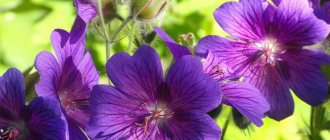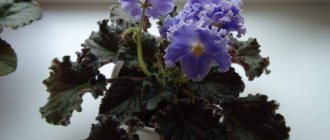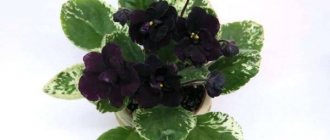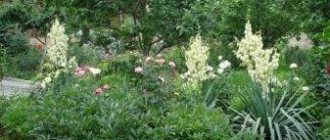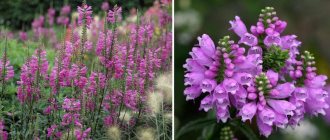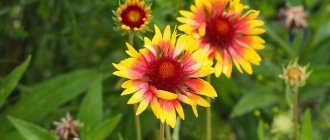Primrose or, as this plant is more correctly called, garden primrose is a very beautiful perennial plant that is the first to bloom in the spring. It has bright colors, and planting and caring for this primrose does not require much effort.
At the same time, gardeners can choose from hundreds of different varieties of primrose, thanks to which they can create the most unusual compositions in their suburban area.
Characteristic
The flower has a well-developed rhizome. In the zone of the root rosette there are leaf plates that are distinguished by their oblong shape. Some species are distinguished by the presence of so-called sessile leaves or petioles. There are also varieties of primrose that have wrinkled or leathery leaves that are greenish-gray in color.
There are no leaves on the elongated peduncles of primrose. Primrose buds can be single or part of common inflorescences. They also differ in their shape.
| Variety of primrose | Description and features |
| Primula vulgare | This is the most common type of plant, which is most often grown at home and looks great in a suburban area. The height of the plant does not exceed 10 cm. The flower has no stems. Multi-colored inflorescences can differ in different shades, ranging from white to deep black. The tricolor petals, which are collected in the shape of an umbrella, look especially beautiful. Primrose usually begins to bloom from February to April. This type of plant withstands night frosts well and is also suitable for growing on a loggia. When winter frosts occur, it is advisable to keep plants at a temperature not lower than -5°C. If the temperature drops below this indicator, then the plants must be brought indoors. |
| Hallera | This is a very unusual variety of primrose, which has almost disappeared. This medicinal plant is found at the foot of some mountains. This primrose grows up to 40 cm. It is distinguished by long leaves that are slightly retracted. The flowers resemble an umbrella with pointed tips. Primrose blooms from March to April. |
| Auricular | This primrose is often found in the Alps or the Balkans. The main feature of this plant is that it needs a large amount of calcium supplementation. In young primroses, the leaf plates are collected into a mundane rosette, which is located on short and wide petioles. Interestingly, the flowers of the auricular primrose smell the same as apricots, which is why they are of interest to gardeners. Plants begin to bloom in late May or early April. |
| Primrose small | This is another highland plant with very compact dimensions, which is suitable for acidic soil, rocky terrace or grassy slope. The primrose is distinguished by a short stem, the length of which reaches 1 cm. The flowers grow bell-shaped and purple. This variety of primrose is very resistant to frost, as it has a much better developed root system. |
| Mealy | This perennial primrose first appeared in Eurasia, as well as South America. The plants grow up to 30 cm high, the leaves have fibers, and the flowers have a pleasant pink hue. Flowering lasts from May to September. |
| High | This variety of primrose can grow up to 40 cm. It is distinguished by ovoid and slightly elongated leaves. Tall primrose flowers usually have two shades at once - with a yellow crown and an orange bud. |
| Retroscopic | This unusual primrose was bred in China. The height of the plant reaches 30 cm. Reverse primrose is distinguished by flowers of white, pinkish, red or a pleasant purple hue with green eyes. The leaves are also very beautiful. They are plugged into a socket. A stem grows from it. |
| Japanese | This unusual plant is distinguished by its decorative characteristics, as well as its unpretentiousness in the growing process. With proper care and watering, the height of the primrose can be 0.6 m. The flowers have a light yellow hue, and the length of the leaves can reach up to 20 cm. The plants reproduce independently, since after the flowering period spherical seed boxes are formed, which disperse the material for subsequent colors. This type of primrose is usually grown in slightly shaded areas. However, these flowers are also perfect for a well-lit place. The main thing is to ensure that the soil is moist and sufficiently acidic. Japanese primrose is quite sensitive to care. If she lacks something, she may die. It also does not tolerate frost very well. |
Perennial garden primrose (planting and caring for primrose will be discussed later in the article) goes well with low-growing and tall plants . Since it has bright colors and is one of the first to bloom, it becomes an indispensable element of the flower bed.
Collection of popular plant varieties
Plants of this group are common in decorative floriculture. A description of the most popular types is presented below:
Primula vulgare stemless
This species has a short root system of thick laced roots and oval leaves with a rough surface. They are highly frost-resistant and can even be left over the winter. Individually arranged flowers are characterized by pale pink and white colors. Prefers partial shade, since in the sun the bushes become smaller and flowering becomes poorer. Primrose is quite unpretentious in care and is able to decorate the garden with its flowers for many years.
Primrose fine-toothed
An unpretentious frost-resistant perennial, which is characterized by oblong leaves, jagged at the edges, which are usually shed for the winter. A thick stalk with a yellowish coating has large spherical inflorescences, which are characterized by white, blue and purple colors. Primrose grandiflora feels good in partial shade in loose, moist soil. One of the most famous varieties that has struck the heart of more than one gardener is violet primrose.
Primrose margo
A well-known large-flowered variety due to its huge variety of shades. Often a mixture of different colors is found, and may also have a distinctive white border.
Primula colossea
A tall plant that takes root well both in sunny areas and in the shade. Remarkably, they are considered the most frost-resistant primroses. It is distinguished by a variety of bright shades of lush inflorescences in the form of umbrellas and large leaves with a rough surface. Colossea is resistant to various diseases and is easy to care for.
Japanese primrose
These species belong to the category of perennial plants and prefer well-lit, moist soils. The leaves are brightly colored and serrated at the ends, and the stems with inflorescences are significantly larger than the foliage located at the base. At the ends of the stem there are spherical inflorescences of a pleasant burgundy shade. Colossea requires regular feeding and watering.
Primrose big ben
Tall perennial flowers of bright color with a rather attractive appearance for the garden, which is of interest to many. The massive flowers have a variety of bright colors, which are collected in umbrella-shaped inflorescences. Prefers partial shade, loose and moist soil, as well as annual addition of soil. It has dark oval-shaped leaves with a rough surface. The only drawback is considered intolerance to cold. The most popular variety is yellow primrose, alluring with its brightness and harmony.
Primrose roseanna
This is the pinnacle of plant breeding. Characteristic features are miniature size, enlarged flower petals, richness and elegance of colors. Terry primrose is highly decorative, thanks to its large flowers, bright oval leaves, compactness and splendor.
To create a flower bed in landscape design, perennial primrose is suitable, which will harmoniously complement the landscape near the house with its variety of colors, early flowering and unusual beauty.
Preparation of planting material and propagation
Primrose can be planted using a variety of methods. As a rule, gardeners prefer sowing seeds. However, almost immediately after purchasing the seed, it needs to be planted. Primrose seeds lose their viability very quickly.
The same applies to those situations when the gardener independently collects seeds after the plants flower. Planting should be done immediately after collection.
For this, ordinary wooden boxes are usually used, which are placed in open soil. If the seeds were purchased in a store, it is recommended to plant them in the first days of February. To do this, the box must be filled with a nutrient substrate, which consists of grain, as well as leaf soil and sifted sand (proportions 2:1:1).
The seeds are distributed over the surface of the substrate, but are not buried into it. No more than 5 seeds can be placed per 1 cm2 of prepared nutrient substrate. After this, the box must be covered with polyethylene and placed in the freezer, where the temperature is maintained at 10°C. The seeds should remain in this state for 1 month.
This hardening procedure is necessary to ensure that young shoots do not die in the open ground immediately after planting in cold nights. After hardening, the boxes can be placed directly in a plastic bag on the window and make sure that they are protected from the morning sun.
As a rule, seeds germinate best at temperatures between 16 and 18°C. The first shoots do not appear immediately, so you need to be patient. Typically, the polyethylene is removed from the boxes after about 2 weeks. Until this point, it is only necessary to occasionally open the seed box and provide the plants with fresh air.
Perennial garden primrose, planting and caring for which does not cause difficulties, takes quite a long time to sprout when grown from seeds. Therefore, many gardeners prefer ready-made seedlings. It is best to purchase seedlings that already have 2-3 full leaves.
This is the optimal state of young flowers for picking into another box (it is better to move the plants to another container using tweezers). The soil in the new boxes must be moistened.
But it must be borne in mind that such young seedlings will be ready for the harsher conditions of open ground only a few years after the appearance of the first shoots. Therefore, you can immediately purchase two-year-old seedlings in the store.
Garden primrose can be propagated by seeds, by cuttings, by dividing bushes or by the leaf method. The latter method is rarely used, and the first one takes too much time.
Primrose after flowering or dormant period
In order for the primrose to bloom long and abundantly, the plant must be provided with the correct rest period. Many novice flower growers, due to their illiteracy, throw away the primrose after flowering. You shouldn't do this.
Attention! If buds appear in the summer, they must be removed.
After flowering is completed, the plant is placed in a ventilated, slightly darkened, cool room. Recommended temperature +10-16°C. The most profitable option for relaxation is placing a flower in the garden or on a loggia or balcony. Water moderately during this period, periodically removing drying and fading leaves.
Preparing the soil and planting site
When choosing a place where the primrose will be located, preference should be given to areas where there is no direct sunlight . But it is better not to plant primroses in the shade either. This should be a place where the sun's rays reach only in the evening, when they are not so aggressive as to cause leaf scorch.
In spring, the plant should receive plenty of light, and in summer, on the contrary, it should be in partial shade.
Based on this, the optimal solution would be to plant garden primrose under trees or deciduous shrubs. In summer, the flowers will be hidden from direct sunlight, and in early spring, when foliage has not yet formed on the trees, the primroses will receive a sufficient amount of light.
But, there are several nuances of growing primroses of different varieties, for example:
- In sunny places it is allowed to plant common primrose. But you need to make sure that the soil never dries out. It is better to choose fertile soil, with humus added earlier. The substrate should be heavy and contain humus. Also, common primrose grows well in loam.
- For powdery or Japanese primrose, it is recommended to prepare a peat substrate.
- The ear-shaped and pubescent primrose prefers soil that contains calcium.
Landing algorithm
It is recommended to plant primrose in open ground at the first thaw in spring or early autumn, but only in the second year of the plant’s life. If you decide to plant primrose in the spring, then in this case it is recommended to carry out the procedure in the last days of May.
Planting in beds and flower beds can also be done in the summer, from mid-July to August. At this time, the primrose seedlings are transplanted to a permanent place. There should be a distance of 20-25 cm between plants. If before this the garden primrose grew in an apartment (for example, it was given as a gift in a pot), then in this case it can be transferred to the garden in March.
How well the plant takes root directly depends on the length of the roots. It is best to replant young plants. If you are transplanting from a pot into open ground, then at first you need to keep the young seedling in partial shade. Once it takes root and begins to develop, you can move it to a sunnier place.
If we are talking about seedlings prepared from seeds, then it is necessary to perform picking several times in a timely manner:
- The first picking is usually carried out 3 weeks after sowing. At this stage, it is necessary to pick young plants into a box, which is first filled with fresh soil.
- The second pick is performed a month later. The plants must be transferred again to fresh soil. In this case, in the new box the distance between plants should be about 45 cm.
- The third picking is performed when the young shoots begin to touch the leaves. This time, planting is done in pots with a diameter of 8 cm. As a rule, this procedure is performed approximately 6 weeks after sowing.
During the first week after the third transplant, the primrose must be watered three times a day, and the windows must be kept closed. After the plants have taken root a little and begin to grow intensively, you can gradually open the windows and ventilate them (first for 10-15 minutes, and then for several hours, 2-3 times a day).
Watering at this time is done when the soil in the pots begins to dry out. If you water young primroses too much, the roots will quickly begin to rot and the leaves will turn yellow.
In mid-July, the primrose should be transplanted for the last time into pots, the diameter of which should be up to 12 cm. At this stage, it is recommended to remove weaker plants. No more than 2 seedlings can be planted in one pot. It is recommended to prepare the soil by adding a small amount of compost. Also, the optimal soil acidity should be pH 5.6-6.
If the soil is neutral or alkaline, then the primrose leaves may also turn yellow and their edges will begin to dry out. This is explained by the fact that organic compounds are still distributed incorrectly in young plants.
Towards the end of September, the primrose can be transferred to a greenhouse in which the temperature is maintained within 10-12°C.
By October, nine-month-old seedlings should be well formed. Then the first inflorescences appear. It is at this stage that primrose seedlings are usually transferred to nurseries or planted in open ground if the seedlings were purchased or grown independently. Fully formed seedlings must be planted at a distance of 0.2-0.3 m.
Care
The perennial primrose requires not only proper planting, but also subsequent care. In the process of growing primrose, you need to follow simple recommendations for care, watering, fertilizing and other tips from experienced gardeners.
Spraying, watering
As a rule, most varieties of garden primrose tolerate drought conditions extremely poorly. In this regard, flowers need to be watered abundantly and regularly. It is important to check that the soil is moist. As soon as it dries, it is recommended to spray or water the plants.
In the conditions of central Russia, abundant watering once a week is sufficient, which includes 10 liters of water. Some people prefer to add 200 ml of water daily, but experienced gardeners advise watering more rarely, but more abundantly.
Much depends on the specific variety of primrose, since some species do not tolerate excess moisture very well. For example, this type includes powdery primrose, which is extremely sensitive to excess moisture, especially in winter. Therefore, this variety is usually planted in so-called permeable soil or in a raised bed.
Top dressing
Fertilizers need to be applied every 2 weeks. You can use standard formulations for flowering plants. Flower growers also recommend preparing your own solution, which consists of 2 g of ammonium nitrate, 1 g of 50 percent potassium sulfate and 2 g of superphosphate.
All these components must be diluted in 1 liter of water. The same mixture is used for seedlings that are in the greenhouse. It is important to ensure that the fertilizer does not contain calcium nitrate.
Transplanting an adult bush
Perennial garden primrose, planted and cared for in accordance with the recommendations of gardeners, is considered mature at 4-5 years. This is an excellent period to rejuvenate the plant. To do this, at the end of the summer season or before the 2nd week of September, you need to perform a transplant.
Transplantation of an adult perennial garden primrose bush is carried out for 4-5 years
The algorithm of actions is as follows:
- An overgrown bush of garden primrose must be watered generously and dug out along with a lump of earth.
- After this, you need to rinse the rhizome of the plant well in lukewarm water to remove the soil.
- At the next stage, you need to cut the roots into sections using a sharp knife. Each of them must have at least 1 resume point. The areas of the resulting cuts must be treated with ash.
- Immediately after treatment, the divided bushes need to be planted in a new place.
- All that remains is to water the primrose well again.
If the rhizome of the plant is too weak or there is only 1 rosette on it, then it is better to use axillary shoots for propagation. To do this, it is enough to separate a healthy leaf, which contains a bud, a petiole and part of the stem.
The resulting planting material must be cut in half and placed in prepared soil. The cuttings obtained by this method must be transferred to a lighted place (but without direct sunlight). When the stems grow from the buds and at least 3 young leaves appear, the shoots can be planted.
Trimming
Primrose leaves are pruned in early spring, as soon as the first snow has melted. In autumn, these measures are not carried out, since foliage is the main source of nutrition for the weakened root system, which will need additional strength in winter. In addition, dried leaves provide additional insulation and a protective layer against frost.
During the flowering process, it is necessary to ensure that faded buds are promptly removed. If left, they will also take nutrients from the plant.
Flower pruning
Caring for primrose is not only about watering and fertilizing; the plant needs to be pruned on time. Not everyone knows which leaves should be removed or whether it is necessary to trim the primrose at all after flowering.
Trimming dry leaves
For indoor primrose, it is necessary to carry out sanitary pruning during flowering and when it fades. In summer, dry leaves of primrose need to be cut off so that they do not interfere. It is impossible to prune the foliage of garden varieties before winter, as it protects the flower from hypothermia. Indoor plants spend the winter indoors; regardless of the season, yellowed leaves should be cut off from an indoor flower.
During the flowering period, primrose needs sanitary pruning; at this time, faded flowers must be removed along with the peduncle stem. If this is not done, they will pull some of the nutrients from the soil. After removal, all the plant’s forces will be directed to the formation of new inflorescences.
A true decoration of any garden or apartment is a blooming primrose; the timing of its flowering depends on how it was cared for and in what conditions it grows. If the plant is provided with the necessary conditions, it will delight with lush flowering for several months in a row.
Possible diseases and pests and ways to get rid of them
The most harmless pests that can harm garden primrose are snails and aphids. As a rule, they appear if the climate is too humid or if the primrose plantings are too thick. There are several methods to get rid of snails.
For example, some use a special granular preparation called Groza. It would also be a good idea to place spruce needles around the plants. Slugs and snails do not like to move on rough or scratchy surfaces.
However, it is first very important to remove them mechanically, that is, you will need to collect all the snails in a container and remove them as far as possible from the plant or burn them.
In order to get rid of aphids, it is necessary to wash all primrose leaves with a weak soap solution, in which any dishwashing detergent is added. If the insect colonies are already too large, then an insecticide will be required. For example, the drug Biotlin or Iskra is highly effective.
Primrose may also suffer from powdery mildew. That is a fungal type disease that first damages the lower leaves, and then rises higher and destroys the entire plant. At the first stage of development of powdery mildew, a light coating appears on the leaves, which is quite easy to wipe off. But then peculiar drops of liquid appear.
They are a product of the maturation of fungal pores. If they are fully formed, it will be very difficult to save the flower, since the damage to the foliage will be irreversible. Therefore, experienced gardeners recommend periodically inspecting the leaves of plants, especially from below.
If the first signs of the development of powdery mildew appear, then you need to treat with Topaz or Fitosporin. If the plants are severely affected, it is better to dig them up and burn them, as powdery mildew can quickly spread to other flowers.
Primrose also sometimes suffers from gray rot. In this case, unpleasant yellow spots appear on the shoots of the plant, around which a brown border forms. Similar signs can be seen when rust appears.
Only in this case the spots are distinguished by a uniform red-brown tint. Gradually, the spots merge and affect the plant with a cavity. Another sign of rust development is the appearance of tubercles on the bottom of the leaf in which spores collect.
Primrose may suffer from:
- Anthracnose. An unpleasant dark coating and small brown spots appear on the leaves, around which there is a yellow or brown border.
- Downy mildew. Transparent spots form on the outer part of the leaf, and whitish mold can be found on the inside of the leaf plate.
- Chlorosis. The leaves become colorless and the buds become deformed. The plant begins to grow much slower and blooms very little.
When these diseases (including rust and gray rot) appear, it is necessary to get rid of the infected parts of the plant, and treat the sections with crushed activated carbon. After this, you need to spray the plants with fungicide and pour a small amount into the soil.
Possible problems
The main problems when growing perennial primrose at home are related to fungal diseases and insect damage.
If signs of a fungal disease are detected - discoloration, the appearance of spots on the leaves, drying of individual small fragments on the leaf blades - the affected parts should be removed immediately. The remaining plants are treated three times with any antimycotic agent. Fundazol, Topsin, etc. are best suited.
If the planting is attacked by spider mites, you should resort to spraying with Actellik. Treatment is carried out 3-4 times at weekly intervals. If there are beetles on the foliage, they must be collected by hand.
Sometimes a plant can wither for no apparent reason. In this case, you need to carefully examine the soil under the root rosette for the presence of nematodes. If parasites are found, then treatment is carried out with the drug "Ragor".
Peculiarities
Perennial garden primrose (planting and care must be done at the right time) looks great in any area. Since the plant is perennial, this allows you to create flowerbed designs that will delight you for many years. Primrose lends itself well to transplantation and propagation. There are many varieties of the flower.
But it is worth highlighting some of the problems that gardeners face when growing primrose:
- If the primrose does not have enough water or is exposed to scorching rays of the sun, it quickly begins to fade.
- When using cold water for irrigation, there is a risk of damaging the root system. If the roots begin to rot, it will be very difficult to notice immediately. There is a risk that the plant will die.
- If the primrose does not have enough fertilizer, the flowers become small and there are much fewer buds.
- An adult plant must not only be replanted, but also the bush must be divided, which takes quite a lot of time.
However, most of these disadvantages of perennial garden primrose are characteristic of many other flowers. Of course, primrose has more advantages than disadvantages. If you plant correctly and do not forget about caring for the plant, it will not cause any trouble.

